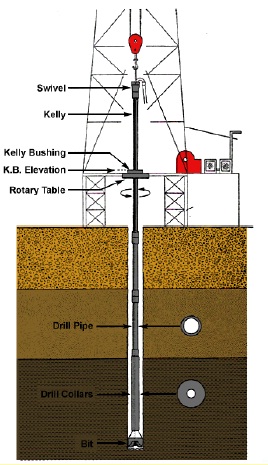Rotating system:
the figure indicate the comparative sizes of the drill pipe and drill collar.
Swivel
♦ The swivel hangs from the drilling hook by means of large bail, or handle. The swivel is not rotate, but allow everything below it to rotate.
♦ Drilling fluid is introduced into the drill stem through a gooseneck connection on the swivel, which is connected to the rotary hose.
Power Swivel
♦ When a ‘top-drive’ system is used, the swivel is replace by power swivel.
♦ The power swivel performs the same functions as the ‘normal swivel’, but it is also associated with a transmission system used to rotate the drill string, instead of the rotary table transmitting this motion.
Read also Testing of Drilling Systems
Kelly
♦ The kelly is approximatel 40 feet long, square or hexagonal on the outside and hollow throughout to provide a passage way for the drilling fluid.
♦ Its outer surfaces engages corresponding square or hexagonal surfaces in the kelly bushing.
♦ The kelly bushing fits into a part of rotary table called master bushing. Powered gears in the rotary table rotate the master bushing, and thus the kelly bushing.
♦ The kelly bushing will rotate the kelly and everything below it to rotate.
Drill String
♦ The drillstring is made up of the drillpipe, drill collars, and specialized subs through which the drilling fluid and rotational power are transmitted from the surface to the bit.
♦ Drill pipe and drill collar come in sections, or joints, about 30 feet long.
♦ The most commonly used diameters of drill pipe are 4, 4½, and 5 inches OD.
♦ The purpose of drill collars is to put extra weight on he bit, so they are usually larger in diameter than drill pipe and have thicker walls.
Rotating Equipment: Drill String
♦ Drill pipe and drill collars have threaded connection on each end.
♦ On drill pipe the threaded connection are called tool joints. Tool joints are steel rings that are welded to each end of a joint of drill pipe. One tool joints is a pin (male) connection, and the other is a box (female) connection.
♦ Specialized Subs: The word “sub” refers to any short length of pipe, collar, casing, etc., with a definite function.
Drill Bit
Read a full article about Drilling Bits
♦ At the bottom of drillstring is a the bit, which drills the formation rock.
♦ Most common types are roller cone bits and diamond bits.
♦ The bit size: range from 3¾ inches (9.5 cm) to 26 inches (66 cm) in diameters. The most commonly used sizes are 17½, 12¼, 77/8, and 6 ¼ inches (44, 31, 20, and 16 cm).
♦ Roller cone bits usually have three cone-shaped steel devices that are free to turn as the bit rotates.
♦ Several rows of teeth, or cutters, on each cone scrape, gouge, or crush the formation as the teeth roll over it.
♦ Two types: milled teeth and tungsten carbide inserts.
♦ Most roller cone bits are jet bits: drilling fluid exits from the bit through nozzles between the cone, thus create high velocity jets of mud. This will help lift cuttings away from the bit.
Circulating System
There are a number of main objectives of this system:
♦ Cooling and lubricating the drill bit.
♦ Controlling well pressure.
♦ Removing debris and cuttings.
♦ Coating the walls of the well with a mud cake.
– The circulating system consists of drilling fluid, which is circulated down through the well hole.
– The most common liquid drilling fluid, known as ‘mud’, may contain clay, chemicals, weighting materials, water
and oil.
– The circulating system consists of a starting point, the mud pit, where the drilling fluid ingredients are stored.
– Mixing takes place at the mud mixing hopper, from which the fluid is forced through pumps up to the swivel and down all the way through the drill pipe, emerging through the drill bit itself.
– From there, the drilling fluid circulates through the bit, picking up debris and drill cuttings, to be circulated back up the well, traveling between the drill string and the walls of the well (also called the ‘annular space’).
– Once reaching the surface, the drilling fluid is filtered to recover the reusable fluid.

